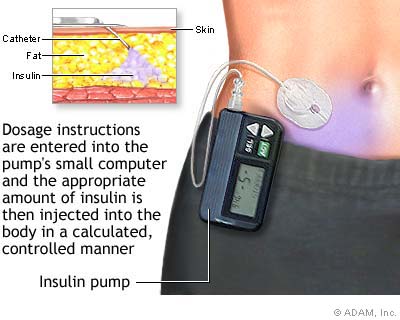Insulin Delivery Systems – The Needle, the Pen and the Pump
Insulin is the lifesaver of a type 1 diabetic. Some with type 2 also depend on this hormone to regulate their skyrocketing blood sugar levels. There are techniques to deliver the needed insulin into your body. It can be injected using a fine gauge needle with an insulin syringe. Or, it can be delivered utilizing an insulin pen which is actually a cartridge pre-filled with the medication. The other technique is through a pump system attached outside the body.
The Needle Technique
This technique delivers insulin in individual doses and is injected subcutaneously. You use a fine gauged needle and a syringe with specially marked increments in International Units.
Most diabetics know this technique. After washing your hand, mix the insulin by gently rolling between your hands or by turning the bottle slowly up and down. Clean the rubber stopper with alcohol, pull the plunger back to the number of insulin needed, push the needle through the rubber stopper and push the plunger, leaving the needle and bottle upside down. The tip of the needle should be in the insulin and then extract the right amount of the hormone.
Select the site, pinch the skin to a mound, insert the needle into your skin at a 90 degree angle and then push the plunger slowly down until all the insulin is injected. Then release the pinched skin, wait for some seconds and pull out the needle.
There are two types of insulin therapy that uses the needle technique the conventional and the intensive which is also called flexible insulin regimen.
— Conventional insulin therapy uses the rapid- or intermediate-acting. Usually, it is injected twice or thrice daily. Meals are scheduled to match the anticipated peaks of insulin profiles. Frequent blood glucose measurements aren’t done. This method is still in use for a small proportion of cases. There is less needle pricks than the intensive insulin regimen.
— Intensive insulin therapy increases the insulin injections to four or more injections a day. Mealtimes are not as rigidly scheduled but can be flexible with variable carbohydrate choices and physical activities.
Obviously, you’ll be using as much as 1,400 needle stick a year. There is the inconvenience of injecting insulin multiple times daily and you have to find a time and place for your insulin injection anywhere you may be.
Blood glucose levels aren’t well controlled in both the conventional and intensive therapy.
The Pen Technique
The pen is a more convenient insulin delivery system. The disposable needle is attached to pen which is actually a cartridge pre-filled with insulin and a dial to measure insulin dose.
The method of using an insulin pen is simple: screw on an unused pen needle, prime the pen to remove any air from the needle, turn the dial to the number of units needed, make a mound in the skin, inset the needle, press the button on the end of the pen to inject the insulin. Count to five and remove the needle straight out.
Apparently, this system is more convenient that the needle technique. It delivers a more accurate dosage with better patient compliance. Different makes of pens are especially suited for older adults, adolescents, children and pregnant women. The insulin needles are smaller and results in lesser pain.
The Pump
An insulin pump consists of a small tank of insulin about the size of a cellphone worn outside the body such as on your abdomen, back, leg or arm. A tiny catheter inserted under the skin is connected to a tube joined to this reservoir of insulin. The insulin pump is programmed by a wireless device.
Pumps deliver insulin in three ways namely: through basal rate, bolus and correction. It supplies small increments of rapid- or short-acting insulin to the body over a 24 hour period and is termed the basal rate. This replaces the need for a long-acting insulin shot that has to be administered twice daily and roughly accounts for 50 percent of a your daily insulin requirement. The boluses are insulin injections administered by the pump for the carbs you eat at meal times while the correction is to adjust the pre-meal insulin bolus for glucose values outside of your blood glucose target range. The basal rates comes as low as 0.025 units per hour and the bolus rates of 0.1 unit doses.
The advantage of the pump is it improves blood glucose control by calculating individualized basal rates. It affords you convenience so that your mealtimes shouldn’t be rigidly scheduled. It also gives you the freedom to choose what to eat.
Additionally, the pump delivers a special meal bolus in the event of delays in absorption of some foods. Thus, large swings of blood glucose levels are avoided and lesser frequency of hypoglycemia even at night.
On the down side, a pump can malfunction it can deliver too little or too much insulin. Since the pump only utilizes rapid-acting insulin, if the pump fails or too little is pumped out you might be at risk for ketoacidosis.
It sounds good to use a pump but it is expensive. With the additional cost of insulin pump supplies replacement and other diabetic supplies most diabetics can’t afford it.
As with the needle and the pen, you’d still have to test your blood sugar levels and have a bolus before meals and check your blood sugar levels before meals and at bedtime.
Your Choice
Choosing the best for you depends on many factors such as convenience and comfort; acceptability and knowledge on the mechanics of its use; how controlled your blood sugar level is; support and guidance from your health care provider; and costs and your lifestyle.






0 Comments
You can be the first one to leave a comment.